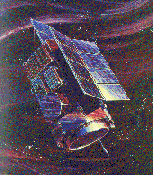|
|
HEAO-1 Software

The analysis of the HEAO-1 A1, A2, and A4 data products can be done
using the XANADU and FTOOLS suite of programs. There are also tasks
available to extract lightcurves from the A2 raw data files. There are
no software available at the HEASARC to analyze the HEAO-1 A3 raw
data. Public domain software can be used to view GIF files (e.g. xv on UNIX
or via the Netscape browser on any system).
 General FITS file manipulation:
The FTOOLS package,
futils, provides a
suite of programs that
can be used to view and manipulate any of the HEAO-1 FITS files.
To view the data particularly useful are the tasks
fplot (to plot the data),
fdump (to dump the data file content), fstruct and
flcol (to get the structure and column name of the FITS files).
Basic selection and column manipulation can be done using
fselect (to select rows based on the result of a boolean expression),
fcalc (to calculate values for new column
based on arithmetic expression) and fstatistic
(to compute standard statistical value on a column).
Alternatively most of the operations (and more) mention above can be
done using fv, the
interactive FITS file viewer and editor.
General FITS file manipulation:
The FTOOLS package,
futils, provides a
suite of programs that
can be used to view and manipulate any of the HEAO-1 FITS files.
To view the data particularly useful are the tasks
fplot (to plot the data),
fdump (to dump the data file content), fstruct and
flcol (to get the structure and column name of the FITS files).
Basic selection and column manipulation can be done using
fselect (to select rows based on the result of a boolean expression),
fcalc (to calculate values for new column
based on arithmetic expression) and fstatistic
(to compute standard statistical value on a column).
Alternatively most of the operations (and more) mention above can be
done using fv, the
interactive FITS file viewer and editor.
 Spectra and Lightcurves :
Spectra and lightcurves can be analyzed using
Xspec and
Xronos respectively.
Xspec is a general spectral fitting programs, providing a number of already
made standard models. To use XSPEC with the HEAO-1 A2 & A4 archive files,
it is necessary to extract from the archive a source and background
spectrum and a response matrix.
Spectra and Lightcurves :
Spectra and lightcurves can be analyzed using
Xspec and
Xronos respectively.
Xspec is a general spectral fitting programs, providing a number of already
made standard models. To use XSPEC with the HEAO-1 A2 & A4 archive files,
it is necessary to extract from the archive a source and background
spectrum and a response matrix.
The HEAO-1 A1 & A2 lightcurves can be used in any of the Xronos programs, each
dedicated to a specific timing task.
Note: The area in the file refer to the
nominal on-axis area of the detector and the spectra have not been
corrected for the reduction in the collimator efficiency during the
period when the source was observed off-axis. Therefore the count rate
and the normalization in the spectral fitting maybe be incorrect.
 A2 Raw rates files :
To extract a lightcurve or a scan profile from the HEAO-1 raw rate and
scanning data, three programs are available :
a2source, a2lcurve, and dsdlcurve. These programs are part of the
HEAO-1 package distributed with the FTOOLS. A2source and a2lcurve
operate on the A2 raw rate data and dsdlcurve operates on the DSDISK data. No
software is available for the LED detectors.
A2 Raw rates files :
To extract a lightcurve or a scan profile from the HEAO-1 raw rate and
scanning data, three programs are available :
a2source, a2lcurve, and dsdlcurve. These programs are part of the
HEAO-1 package distributed with the FTOOLS. A2source and a2lcurve
operate on the A2 raw rate data and dsdlcurve operates on the DSDISK data. No
software is available for the LED detectors.
- Extracting a lightcurve from the A2 Raw rates files.
The first step in extracting a lightcurve from the raw rates files is
to determine which files contain times when the HEAO-1 A2 MED
and HED detectors viewed the sky position containing the
source. A2source, for a given sky position, provides a listing of
these files. After a file listing is available a2lcurve operates on
the 5.12 sec raw rates data from either the MED or HED detectors and
extracts a lightcurve. A2lcurve allows for small or large field of
view lightcurves to be extracted based on the choice of "discovery scalars". An example of the use of these routines on the source SMC
X-1 (coordinates R.A.(1950)=01h 15m 45.7s, Dec (1950)=-73° 42' 21.8'') is
given here.
- Extracting a scan profile from the A2 DSDISK files.
Dsdlcurve uses the raw scanning data and accumulates a 25 degree
scan profile in the vicinity of the source position during all times
when the source was in the detector FOV. An example using
dsdlcurve is given here.
 A2 Raw rates Analysis Issues :
A2 Raw rates Analysis Issues :
[HEAO-1 Home]
[About HEAO-1]
[Archive]
[Software]
[Gallery]
[Publications]
Page authors: Lorella Angelini Jesse Allen
HEASARC Home |
Observatories |
Archive |
Calibration |
Software |
Tools |
Students/Teachers/Public
Last modified: Tuesday, 21-Apr-2020 15:04:51 EDT
|


